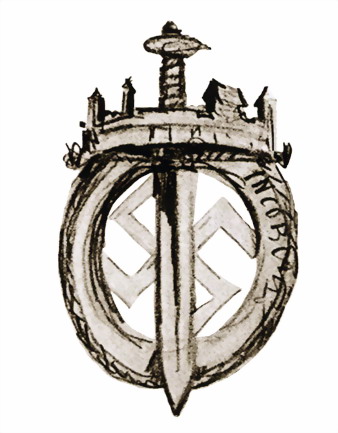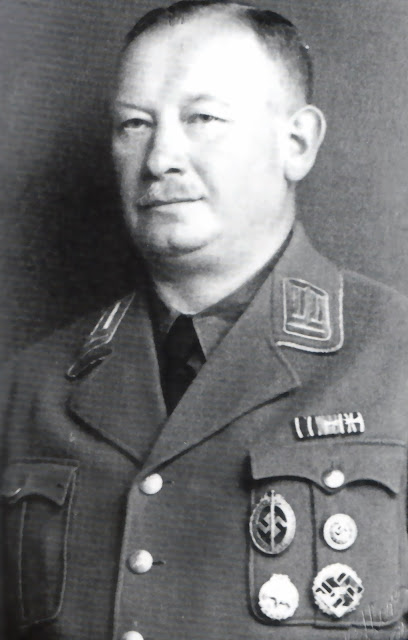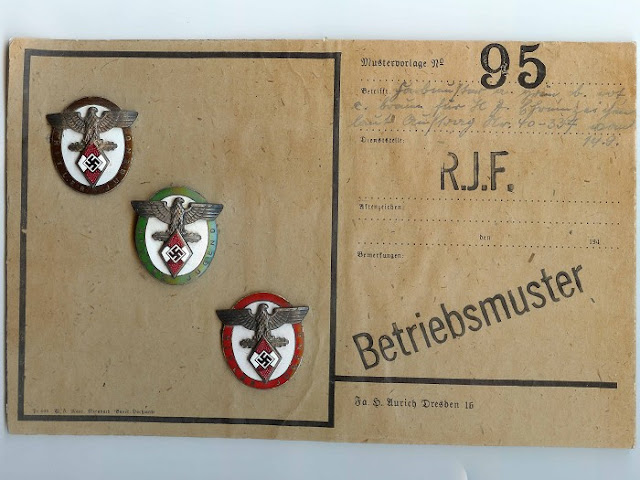Hitler Youth Proficiency Badge – Iron, Bronze and Silver Class.
Instituted - June 1934
Rarity – Common, Scarce, Scarce.
Known Makers– M/34, M/36, M/63, M/101,
The basic design of these three badges is the same with only the colour of the Class differing to indicate the grade of the award. The badge comprises of a Tyr-Rune or runic T, which measures 51 mm high and 6 mm across the arm. On to this is superimposed a circle that measures 30 mm across and 7 mm wide, with a voided centre. Upon this is a swastika, which is just proud of the rest of the badge. The gaps between the arms of the swastika have nine fine 'V' shaped lines. On to the flat field of the circle is superimposed, in raised sham runic script, 'FÜR LEISTUNEN IN DER HJ', which translates to, For Proficiency in the HJ.
The Iron Class finish was white metal painted black, with the swastika and lettering left the base colour. The Bronze Class finish was a bronze wash applied over a white metal badge that was then artificially patinated. The Silver Class finish, was likewise silvered and darkly patinated on the circle and swastika, with the highlights of the letters polished.
The reverse was plain with a pin that varied in size and was held to the centre of the swastika with a plate. The design of this can also vary quite considerably. It has the RZM logo and the M1/ and the maker's number with the badge issue number stamped in. An A B or C grade to denote the proficiency achieved in the relevant class, was sometimes stamped on the reverse of the badge but most examples are without this, as the entry in the proficiency book was relied upon as proof of attainment.
The award was instituted in three classes in June 1934 by Reichsjugendführer Balder von Schirach, as an incentive to improve the physical and ideological proficiency of the varying age groups of the growing membership of the Hitler Youth. It was stated at the time that the HJ achievement badge was a prestigious award which every fit and ambitious Hitler boy and HJ leader should aim for. It was only to be awarded by the Reichsjugendführer to those who meet the stringent requirements that had been laid down. Those who wished to be awarded the badge would have to take a very keen part in at least 8 ideology study periods. These would be held as part of weekly meetings. All members of the Hitler Youth were issued a Leistungsbuch to record the achievements of the members and then to act as a certificate of proficiency. For members of the Marine-HJ and the Motor-HJ there were to be additional tasks, which would test the disciplines specific to these respective organisations. DJ and HJ boys were issued a book with one set of grading standards while the JM and BDM girls were given a book with another set. The award was primarily intended to test the abilities of the members in the following areas, Sport, Small-calibre (or air-rifle) shooting and Field Exercises.
The achievement badge was awarded on three levels:
Iron Class - (Grades A, B, C).
This class could be awarded to DJ and HJ members, and was restricted to boys of fifteen years old. After 26th September 1935 with the introduction of the German Youth Proficiency Badge, the DJ members were no longer eligible and took a qualifying test for their own badge.
Bronze Class - (Grades A, B, C).
This badge was awarded to sixteen-year-old boys of the Hitler Youth.
Silver Class - (Grades A, B, C).
This badge was awarded to seventeen-year-old boys of the Hitler Youth.
The members undertook a test leading to an award of the badge that consisted of a four-part test, which showed clearly how all HJ training was military oriented.
a) Sports, athletics and gymnastics. 100 metres sprint, 300 metres
run, long jump, putting the shot, throwing the hammer,
Horizontal bar exercises and swimming.
b) Shooting with air rifles from the prone position, grenade
throwing with dummies.
c) Field exercises, route marching in full kit, map
reading, distance judging, effective use of terrain and
camouflage.
d) Political knowledge. This comprised a slight knowledge of
history and the absorption of Nazi dogma.
The tests were the same for all three age groups but the scoring varied.
15 year olds
100 metres sprint - 15 seconds, to swim for 5 minutes, to march with full pack for 10 kilometres.
16 year olds
100 metres sprint - 14.5 seconds, to swim for 10 minutes, to march with full pack for 20 kilometres.
17 year olds
100 metres sprint - 14 seconds, to swim for 15 minutes, to march with full pack for 25 kilometres.
The fourth test of political knowledge was dropped during the war, when the emphasis was on physical fitness and Para-military training. The flying HJ, motor HJ and marine HJ had additional tests appropriate to their speciality. The regulations also stated that where swimming facilities were not available, speed cycling could be substituted. The route march had time limits within which the distance had to be covered and these also varied with age. Capable people should be educated to become strong in mind and body and to be filled with national socialist will. These awards did not require exceptionally high individual achievement. Good results in all aspects of physical fitness would however be required. The aim was a varied and harmonious physical education for each German boy and the physical toughening of Germany's youth in general with a unified aim and a clear direction.
Requirements for the achievement tests
Level A - 15 yrs
100m dash - 15secs
3000m run - 15mins
Long-jump - 3.75m
Club-throwing (lane width 10m - club weight 500g) - 25m
Shot-putt - 6m
Chin-ups - 2
Swimming* - 100m no time limit or
endurance swimming 5mins or
Cycling (where swimming cannot be arranged) - 10km no time limit
* mandatory unless no opportunity for swimming is available within 1 hour marching distance
Level B - 16 yrs
100m dash - 14.5secs
3000m run - 14mins 30 secs
Long-jump - 4m
Club-throwing ( - 30mlane width 10m - club weight 500g)
Shot-putt - 6.75m
Chin-ups - 3
Swimming* - 200m or
endurance swimming - 10mins or
Cycling (where swimming cannot be arranged) - 15km in 40mins
* mandatory unless no opportunity for swimming is available within 1 hour marching distance
Level C - 17 yrs and above
100m dash - 14secs
3000m run - 14mins
Long-jump - 4.25m
Club-throwing (lane width 10m - club weight 500g) - 35m
Shot-putt - 7.5m
Chin-ups - 4
Swimming* - 300m or
endurance swimming - 15mins or
Cycling (where swimming cannot be arranged) - 20km in 50mins
* mandatory unless no opportunity for swimming is available within 1 hour marching distance
Aiming and marching exercises:
Level A (15yrs)
1. Club-throwing accuracy test - no run-up. Club weight 500g. Wearing HJ uniform less marching equipment. Target: 4m diameter circle placed at a distance of 15m.
5 throws - 3 must hit the target.
2. Shooting:
Small-calibre*, target distance 50m. 12-ring target with rings spaced 1cm apart. Each shot is to be indicated before firing is resumed.
5 shots in the prone supported position. No shot is to be worth less than 4 points. Alternatively: 5 hits on target to achieve a total of 25 points or more.
* If facilities for small-calibre shooting are unavailable for levels A and B then it is permitted to conduct the test using air-rifles. Distance to target 8m, 12-ring target with rings spaced 0.5cm apart. The requirements for levels A and B are the same as for small-calibre shooting.
3. Marching in HJ uniform
10km to be completed in a time between 2 and 2 1/2 hours carrying extra weight of 5kg.
Level B (16 yrs) and Level C (17+) level of difficulty increases as follows:
Club-throwing accuracy test: distance increases to 20m for Level B and 25m for Level C. Shooting: Level B.
5 shots prone position, weapon supported. No shot to be worth less than 5 points. Alternatively: 5 shots on target to achieve a total of 30 points or more.
5 shots prone position, weapon unsupported. No shot to be worth less than 4 points. Alternatively: 5 shots on target to achieve a total of 25 points or more.
Shooting: Level C. (must be small-calibre)
5 shots prone position, weapon supported. No shot to be worth less
than 6 points. Alternatively: 5 shots on target to achieve a total of
35 points or more.
5 shots prone position, weapon unsupported. No shot to be worth less
than 5 points. Alternatively: 5 shots on target to achieve a total of 30 points or more.
Marching: distance increases to 15km to be completed in a time between 3 and 3 3/4 hours for Level B and to 20km to be completed in a time between 4 and 5hrs for Level C. Excess weight remains at 5kg for Level B but rises to 7.5kg for Level C.
III. Field Exercises
1. Ground appreciation
Level A - not tested
Level B and Level C - Describe geographical features and identify cover in a section of ground 100m wide and 300m deep
2. Map appreciation
Level A - Demonstrate knowledge of map symbols on a 1:100,000-scale map.
Level B - Find direction-using compass. March to a point (2km-3km distance) marked on a 1:1000.000 scale map.
Level C - Establish direction using compass, watch and the stars. March to a point marked on a 1:1000.000 scale map. Point to be 2-3km distant. Pinpoint the positions of two locally visible geographical features on a 1:1000,000 scale map.
3. Target appreciation.
Level A - Identify and correctly describe two obvious ground features at a distance up to 150m
Level B - Identify and correctly describe two less obvious ground features at a distance up to 250m
Level C - Identify and correctly describe two obvious ground features and two less visible ground features at a distance up to 400m
The tests are considered successfully passed if at least 50% of the features are identified and described correctly.
4. Distance appreciation
Level A - correctly estimate the distances to 2 features situated between 50m and 250m away from the viewer.
Level B - correctly estimate the distances to 3 features situated between 50m and 400m away from the viewer
Level C - correctly estimate the distances to 4 features situated between 50m and 800m away from the viewer
Errors greater than 30% constitute a fail.
5. Making of Reports
Level A - Demonstrate knowledge of the contents of a verbal report. Fill out a report card
Level B - Memorise and pass a simple verbal report
Level C - Pass a self-prepared verbal report concerning an enemy position.
6. Camouflage
Level A - Show how locally available materials can be used as camouflage.
Level B - Show how locally available materials can be used as camouflage. Prepare personal camouflage for use in easy ground.
Level C - Show how locally available materials can be used as camouflage. Prepare personal camouflage for use in easy ground. Prepare personal camouflage for use in difficult ground.
7. Approach to the enemy
Level A - complete a hidden approach to an enemy position 100m distant in easy ground.
Level B - complete a hidden approach to an enemy position 200m distant in easy ground.
Level C - exploit ground features to reconnoitre an enemy position 400m distant.
Those were the requirements for the standard HJ achievement badges. The Motor-HJ and the Marine-HJ had specific tests, which replaced parts of the standard testing. Translation continues:
Note: The Motor HJ and Marine-HJ were awarded the same achievement badge (HJ-Leistungsabzeichen) as all other sections of the Hitler Youth but the testing included a section specific to both specialist arms and I'll detail this below. Only boys aged 16 and 17 years or over (Level B and C) were subject to these additional tests.
Motor-HJ
III Motorsport
1. Engines
Level A: Answer three questions of a technical nature. One question to include the drawing of a diagram.
Level B: Answer five questions of a technical nature. Two questions to include the drawing of a diagram.
2. Traffic Regulations
Level A: Answer three questions on traffic regulations. One question to include the drawing of a diagram.
Level B: Answer five questions of a traffic regulations. Two questions to include the drawing of a diagram.
3. Traffic Law
Level A: Answer three questions on traffic law.
Level B: Answer five questions on traffic law.
4. Driving
Level A: Answer three questions related to the actions of a driver before, during and after a journey. Replace the front wheel of a vehicle.
Level B: Assess the condition of a vehicle (to be provided) with regard to traffic regulations. Replace the rear wheel of a vehicle. Perform two driving skill tests. Complete a cross-country drive over moderate to difficult terrain.
Marine-HJ specific tests
The Marine-HJ was not required to complete the foot march over 10, 15 or 20km
Swimming difficulty level for Marine-HJ increased to:
Level A: 300m swim to be completed in 12 minutes or endurance swim of 15mins.
Level B: 300m swim to be completed in 10 minutes or endurance swim of 20mins.
Level B: 300m swim to be completed in 9 minutes or endurance swim of 30mins.
Some of the things mentioned in the following section are not tests but rather prerequisites. See 'Seamanship' which indicates that the disciplines were not tested but rather that they were prerequisites for any boy wishing to achieve his badge. Much like the requirement to have a pen in your hand if you plan to write a letter.
.
IIIa Marine Sport
1. Crew tasksa.) Knots and splices
Level A: Tie 3 knots
Level B: Attach ropes to posts or clamps using 5 different knots.
Level C: Attach ropes to posts or clamps using 5 different knots and one splice.b.) Throw a heaving line
Level A: 10m
Level B: 12.5m
Level C: 15mc.) Seamanship
Level A: Conduct of a passenger in a rowing boat. Rowing to a tempo.
Level B: Practical knowledge of boat types and associated equipment. Complete full rowing training. Learn basic sailing terminology.
Level C: Knowledge of commands for the crew of a rowing boat. Conduct whilst in command of a rowing boat. Sailing in easy conditions.e.) Marine Navigation
Level A: Knowledge of the division of the compass in lines and degrees.
Level B: As for Level A but with the following additions: knowledge of basic avoidance (anti-collision) rules and of navigation lights.
Level C: As for Level B but with the following additions: knowledge of communication at sea.
2. Signalsa.) Semaphore
Level A: 90 letters in 5 minutes. Maximum of 6 mistakes allowed.
Level B: 90 letters in 4mins 30 secs. Maximum of 6 mistakes allowed.
Level C: 90 letters in 4mins. Maximum of 6 mistakes allowed.b.) Morse code
Level A: 90 letters in 10 minutes. Maximum of 8 mistakes allowed.
Level B: 90 letters in 9 minutes. Maximum of 8 mistakes allowed.
Level C: 90 letters in 8 minutes. Maximum of 8 mistakes allowed.
In 1934 issue figures were; Bronze 35900 and Silver 76100. War brought not only a great expansion of numbers conferred but also an extension of eligibility to non German counterparts who were boys from the pro Nazi movements of occupied Europe, so by the end of 1943 when the last accurate statistics were available, the numbers awarded had risen to; Bronze 103061 and Silver 217093.
Early regulations were unclear as to where the award would be worn and it was usually worn on the right side. However, later regulations specified that it would be worn on the left breast pocket. The badge could be worn by members of the HJ, SA, SS, RAD and the military on their uniform. A cloth version was worn on the athletic shirt and a miniature version was authorised for wear on the lapel of civilian clothes.
Miniature Version.
Silver Class - (Grades A, B, C).in cloth on Black backing.
Silver Class - (Grades A, B, C).in cloth on Black backing in wear.
The HJ-Leistungs Badge being presented by an HJ-Bannführer.































.jpg)
.jpg)















































+student+1+REVISED+IMAGE.jpg)


















































































